
Books Nippon was/is the American branch of Nippon Shuppan Hanbai, Japan's largest book distributor! At some point in the early 1980s, they figured that there might be a little money to be made out of re-routing a bit of the gigantic tidal wave of anime books and magazines currently submerging Japan towards the United States, where a small but devoted audience of what would one day be known as 'otaku' waited, cash in hand, for their chance to buy Roman Albums and This Is Animation books.
Earlier Books Nippon catalogs were xeroxed and had a charming punk rock cut-and-paste aesthetic that resembled the fan pages of your better anime magazines.

Even though Cat's Eye isn't about three detectives, somehow the friendly clip art and hand-lettered copy makes you want to shell out $3.30 for "black and white comic novels". This is back when the word "manga" wasn't a overused tagline and the yen-to-dollar conversion was a lot easier to calculate.
But even the friendliest of graphic design has to move with the times and soon Books Nippon's catalog got all professional-looking with screentones and set type and everything.
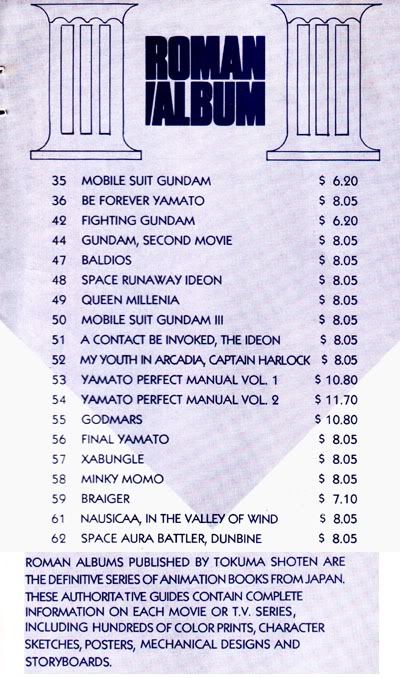
When you're back in 1984 be sure and pick me up some Roman Albums, okay? I will gladly shell out $7.10 for the Brygar Roman Album! Publisher Tokuma Shoten's guides to the anime world, "Roman Albums" were/are thick paperbound magazine size books jam packed with production art, story notes, character designs, color pages, posters, stickers, and other bromides, and were absolutely vital for the informational needs of anime fans circa 1984 and beyond.
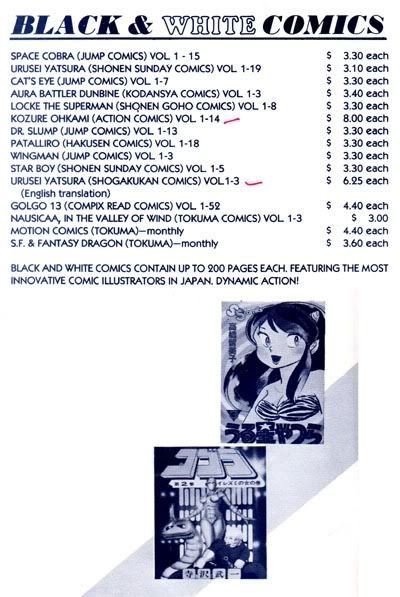
Another "thank you" goes out to Books Nippon for introducing us to the world of "black and white comic volumes" based on our favorite anime! Turns out it's the other way around, that many of our favorite anime series were based on the comics. Or "manga" as we later learned to call them. All your favorites are here - Urusei Yatsura, Space Cobra, Dr. Slump, Locke The Superman, Golgo 13, and Patalliro. 24 years later, however, and I am still unsure what "Star Boy" is. I'm pretty sure they don't mean THIS "Star Boy."
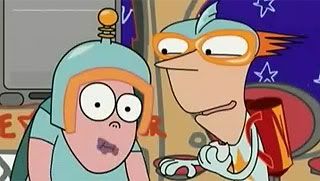
The Keibunsha Daihyaka books are great little bricks of data; written for grade-schoolers, the Japanese is simple, the kanji are all ruby-equipped, and the photos are big and grainy.
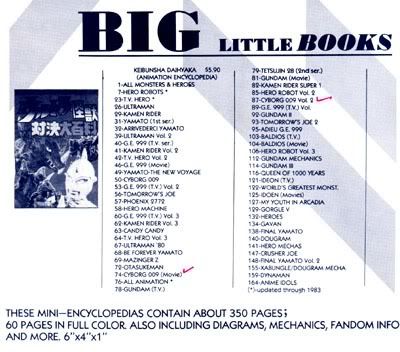
I find myself hauling out my "All Animation" volume for reference a lot more than you'd think. Okay, so it's only updated through 1983, but who cares?
Probably the best part about the Books Nippon 1984 catalog is that it was, for many of us, the very first place to ever advertise Japanese Animation video tapes for sale. And I use the word "sale" very loosely, because HOLY CRAP CHECK OUT THOSE PRICES!!

Do I LOOK like I have ONE HUNDRED AND SEVENTY UNITED STATES DOLLARS to shell out for the first Space Cruiser Yamato movie? Minimum wage back then was $3 an hour. Do the math. Prices on commercial releases of anime remained high for most of the decade, leading to a thriving bootleg video market and the sad spectacle of little clubs of fans pooling their money to buy Crusher Joe or Urusei Yatsura Only You or Final Yamato at the bargain price of $202. I think these days you could fill a cargo container with anime VHS for two hundred and two dollars and hand them out on Halloween like circus peanuts. Beta - TWO cargo containers.
But that's not all Books Nippon offered - they carried a full line of fashion magazines, the charmingly censored Japanese edition of PLAYBOY, and a full page offering glossy color magazines all about your favorite British pretty-boy bands.
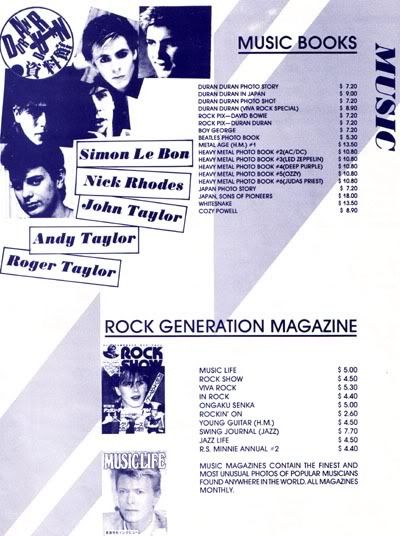
24 years later, and the teenage girls have abandoned Duran Duran for the manga - sorry, the "black and white comic volume" section at Barnes & Noble! And thus, the great circle of life... continues.



